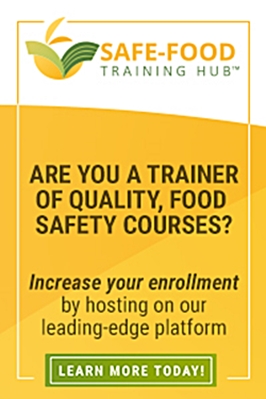Incenting Safety
 The critical need for greater transparency and expediency in food safety was evidenced for me last week on out and back flights between Denver and Frankfurt. Lufthansa handed each passenger a two-page warning and questionnaire about the E. coli outbreak in Germany which has already killed at least 37 people and cost at least $300 million US (http://www.dw-world.de/dw/article/0,,15154072,00.html). As I traveled, rumors were swirling, tempers were flaring (rightly so, considering the casualty rate) and overall there was a feeling of frustration at how long it was taking to unravel the mystery of the murderous meals. How can a society with email, social websites, ubiquitous mobile phones, and always-on infrastructure be so slow in responding to food safety meltdowns?
The critical need for greater transparency and expediency in food safety was evidenced for me last week on out and back flights between Denver and Frankfurt. Lufthansa handed each passenger a two-page warning and questionnaire about the E. coli outbreak in Germany which has already killed at least 37 people and cost at least $300 million US (http://www.dw-world.de/dw/article/0,,15154072,00.html). As I traveled, rumors were swirling, tempers were flaring (rightly so, considering the casualty rate) and overall there was a feeling of frustration at how long it was taking to unravel the mystery of the murderous meals. How can a society with email, social websites, ubiquitous mobile phones, and always-on infrastructure be so slow in responding to food safety meltdowns?
Is there a reader out there who isn’t worried about the safety and integrity of the global food supply chain? OK, probably not on this website. Regardless, the E. coli outbreak in Germany—arguably the most universally advanced of the major economic powers—underlines the fact that global food safety is one of the most important problems in the world of the 2010s. A world where supply chains are often more convoluted than the brains of those who have to manage them. A world where food processing practices often seem designed to purposely obfuscate the producers and distributors in the food supply chain. A world, in short, of increasing complexity and decreasing transparency.
It is, of course, easier to identify a problem than to fix it. However, this doesn’t mean that the solution to a problem has to be onerous. This blog focuses on incarnating the idealism of a philanthropic approach to food safety by creating a system that is profitable for all involved. I believe that a system for food safety can be profitable for all parties involved while significantly decreasing the severity of food safety crises such as the one occurring this month in Germany.
While it is possible to mandate food safety—driving it into the marketplace with standards, regulations, audits and penalties—using this “big stick” approach as the means to grow adoption for food safety practices is not likely to be as successful as a blue ocean (http://www.blueoceanstrategy.com/) approach that rewards all parties involved. These parties include at minimum the producers, distributors, retailers and customers. Let us consider each of these in turn.
 This should be the scariest thing you see in Germany.
This should be the scariest thing you see in Germany.
Producers are responsible for growing the crops, raising the animals, harvesting the fruit, and tending the lands and facilities needed to sustain the productivity of the producer’s facilities over time. Producers can be incented to improve global food safety in one or more of several ways. The first is the direct incentive.
In adopting best practices, such as providing item or shipment level unique identification of their product, the producer can be given a premium on payment which is a fraction of the logistics savings that the distributors and retailers will benefit from. Among several indirect methods, the producers can benefit from the now-possible aggregate analytics that can be provided by the distribution network because of the increased transparency they enjoy from the adoption of the unique identifiers by the producers. These analytics can include helpful information on the effects of different factors—planting time, breeding time, weather, etc.—on the overall yield efficiency of the producers in the network.
Distributors, of course, benefit significantly from the increased transparency of the supply chain. This is precisely the purpose of sophisticated—yet easily adopted—standards such as GS1’s GTIN (http://www.gtin.info/) and SGTIN (http://www.bisg.org/docs/EPC_SGTIN_96.pdf). With an appropriate inference model—linking packages to pallets to crates to shipping units—such standards can provide instant linking between items. This aids in stock management, shipping efficiency and of course other logistics such as change in destination and recall. In the general sense, we can include brand owners—particularly the big, multi-national consumer packaged goods (CPG) brands—in this category.
Retailers also benefit from these same improvements in logistics and stock management. In addition, the adoption of unique identifiers—now at the individual item for sale level—means that each item sold can be non-arbitrarily disambiguated from all other items. This provides a plethora of opportunities for the retailer to connect the customer to the product—and in many cases back to the brands as well. The unique identifiers can be incorporated into customer loyalty, couponing, and even gaming/lottery services that are the on-ramp for copious and quite valuable analytics that the retailer can use to gage customer behavior, receptivity to different retail programs, and more.
Customers have benefitted from what I call “the Revenge of the Physical.” QR codes, Data Matrix codes, and a wide variety of other variable data printed structures have revitalized the role of printing in the electronic world. Suddenly, the same barcodes used for supply chain logistics, track and trace and even point-of-sale can be used for customer/product interaction. Consumers benefit not just from the loyalty, coupon and gaming programs introduced above: in addition, these variable-data printed marks can connect the customer directly to on-line information. The consumer can capture comparative pricing, product ingredient, product manufacturing and other salient information even before purchasing the product. The customer gains, even if she pays for this information (e.g. when texting the information, the customer may pay a nominal fee—a few tenths of a cent, typically—to communicate the number). Smartphone cameras are ubiquitous, and so there are many other services connecting the customer’s product packaging or label to on-line content.
The overview of the Blue Ocean for incenting food safety provided above is certainly a shallow one; nevertheless, it does show how all parties can gain from increased transparency of the supply chain. It is worth pointing out that both security and privacy can be built into the overall network of producers, distributors, brand owners, retailers and customers described. I would be remiss to point out some of the other benefits of increased transparency offered by the combination of item-level tagging and inference. One is product recall, which is precisely focused on speeding up the response time to crises such as the E. coli scare. The other is product anti-counterfeiting. As Raymond Baker (http://en.wikipedia.org/wiki/Raymond_W._Baker, private conversation) has mentioned to me, the single most effective method to fight fraudulent behavior is to have full transparency.
There is always a delicate balance of philanthropy and profit.
In the network described above, every legitimate actor wins. The Producer benefits from improved efficiency and pricing. The Distributors and Retailers benefit from improved logistics and responsiveness. The Retailer also benefits from analytics driven by customer/product interaction. Finally, the Customer benefits from improved product information and from Retailer and Brand implemented services such as loyalty and coupons programs. The Customer also benefits indirectly from the improved speed of recall, which helps minimize the impact of food safety scares such as are reported weekly by the US Food and Drug Administration (FDA) (http://www.fda.gov/Safety/Recalls/default.htm), among others.
It really is a Blue Ocean. Give it a swim.
—Steve

Categories: Risk Management
Tags:




